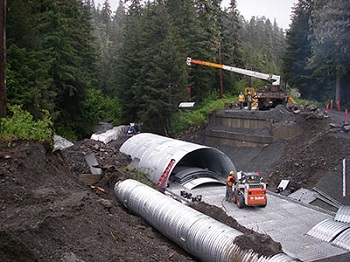Accuracy Pad Construction for Stable Foundations
Accuracy Pad Construction for Stable Foundations
Blog Article
Culvert Setup Facilitated: Step-by-Step Overview for Success
Mounting culverts might appear like a straightforward task, yet making certain an effective end result requires cautious planning and execution. From picking the proper culvert size to integrating appropriate water drainage procedures, each action in the installment process plays an essential function in the capability and long life of the culvert system. By adhering to a systematic approach and paying attention to crucial details, the installment can continue efficiently, lessening potential issues down the line. Keep tuned to discover the essential actions and considerations that can make culvert installation a smooth and successful endeavor.
Selecting the Right Culvert Dimension
Selecting the proper culvert size is important for making sure efficient water circulation and architectural integrity in culvert installment tasks - Pad Construction. The dimension of the culvert directly affects the circulation capacity of water with the structure. A culvert that is too tiny can lead to flooding and overflow, while one that is as well huge may lead to lowered water speed, possibly causing sediment accumulation and clogs
To determine the right culvert size, aspects such as the watershed location, peak flow prices, and hydraulic efficiency requirement to be meticulously considered. Computations based on these criteria help in selecting a size that can adequately deal with the anticipated water volume while minimizing the danger of obstructions and architectural failing.
It is important to consult engineering guidelines and standards to guarantee that the selected culvert size fulfills the project requirements and local policies (Pad Construction). By choosing the ideal culvert dimension, project managers can optimize water flow, prevent potential concerns, and improve the general efficiency and durability of the culvert setup
Preparing the Setup Website
Reliable culvert installment demands careful preparation of the installation website to guarantee ideal structural assistance and functionality. Prior to beginning the installment process, it is vital to clear the website of any particles, vegetation, or blockages that could restrain the culvert's placement.
Moreover, it is necessary to consider aspects such as soil composition, groundwater levels, and environmental influences when preparing the installment site. Carrying out a thorough site assessment can help identify any kind of possible obstacles or dangers that might impact the culvert's performance. By making the effort to prepare the installation website correctly, you can aid assure an effective culvert installation that satisfies structural demands and makes certain long-term functionality.
Putting the Culvert Properly

The grade at which the culvert is placed is vital for keeping a proper incline for water circulation. A progressive slope aids stop merging and advertises efficient drain. In addition, the culvert ought to be oriented correctly to guarantee that the inlet and outlet remain in the appropriate places. This alignment is necessary for the culvert to operate effectively in taking care of water flow.
Backfilling and Compacting the Soil
Correct backfilling and compaction of the soil around the culvert is vital to make sure stability and protect against potential concerns in the future. As soon as the culvert is properly put, the next important action is to backfill the location around it with ideal product. The backfill material need to be without rocks, debris, and raw material to avoid damages to the culvert. It is recommended to Continue use granular material such as sand or crushed rock for backfilling, as it supplies excellent drainage and compaction buildings.
Compaction assists in lowering the opportunities of settlement and ensures consistent support around the culvert. It is important to small the dirt uniformly on all sides of the culvert to keep its architectural stability.
Proper backfilling and compaction not only offer security to the culvert but also assist in preventing soil erosion and preserving the longevity of the culvert system.
Ensuring Proper Water Drainage Integration
Incorporating effective drainage options plays a vital role in the overall capability and long life of culvert setups. Appropriate water drainage integration is crucial for managing water flow, preventing disintegration, and guaranteeing the architectural honesty of the culvert system. To attain this, it is vital to develop a comprehensive drainage plan that takes into consideration variables such as the volume of water expected, the topography of the location, and the sort of soil present.

Additionally, including functions like erosion control procedures, such as riprap or plant life, can further enhance the effectiveness of the water drainage system. By very carefully intending and executing these drainage remedies, culvert installations can operate effectively and hold up against the test you could try these out of time.
Conclusion
In final thought, appropriate culvert installment is critical for preserving effective drain systems. By selecting the right culvert dimension, preparing the installation site, putting the culvert appropriately, backfilling and condensing the dirt, and ensuring appropriate drainage integration, success can be accomplished. Following these steps will assist ensure the durability and effectiveness of the culvert, inevitably adding to the general success of the water drainage system.
Report this page